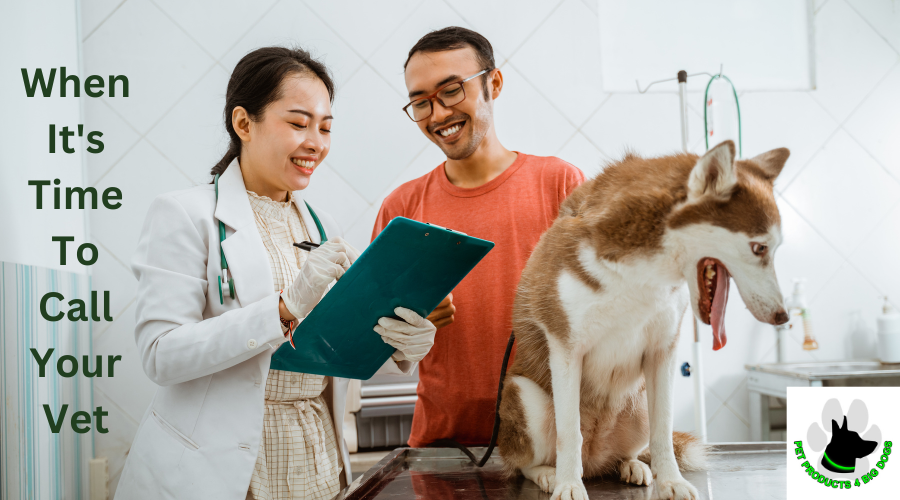We love our dogs and hopefully, most of the time your dog will be in great health. But things happen and it’s time to reach out for some expert advice (not Dr Google) and talk to your vet. I should pre-empt this by saying I am not a vet, nor is this veterinary advice; just some tips as a fellow dog lover that it might be time to talk to your vet.
Time to Call Your Vet
Excessive thirst
If your dog is drinking more than usual and excessively, consider the conditions. If s/he’s been running around a lot, or it’s particularly warmer weather, that might be the reason. However, do keep an eye on things and keep track of actually how much water s/he is drinking. I know myself, my big boy was drinking about 3 litres of water a day and we had the tests which found he didn’t have diabetes or kidney problems, but I’m really glad I did the testing. If there was a problem we could work towards problem-solving and if there isn’t, then you can stop worrying. It’s just better to know.
Changes in the stool
A healthy and normal dog stool is moist and firm. If your dog has hard and dry stools or difficulty (straining) pooping it may be a sign of dehydration, illness or even dietary problems. Also watch out for worms, blood, or mucus present in the stool or diarrhea for more than 24 hours.
Changes in their eating habits
If your dog is unusually ‘starved’, hungry or desperately begging for food and really trying to get their paws on anything and everything – it might be a medial issue. It probably isn’t an emergency, but it’s worth talking to your vet about. Likewise, if your dog is off their tucker for a reasonable period of time, best you talk about this to your vet too. Sure, dogs have days (especially if their routine is changed, like when you go away on holidays) they may be ‘off’ their food a day or so, but appetite should return.
Scooting
While scooting their bottom on the floor may resemble a silly dog trick, and yes, even be annoying if it’s done on your carpets. This can be a symptom of a few things, including anal gland problems, worms, bowel issues or even an urinary tract infection.
Vomiting
Whilst most dogs experience vomiting at some point or another – often to rid something from their system or stomach – do reach out to your vet if it’s frequent or they are vomiting blood. Naturally the younger the dog, the sooner you take action.
Lumps, bumps and growths
Firstly, check that a small lump isn’t a tick, and if it is, then treat immediately. Watch any unusual lumps or bumps closely. It can be anything from fatty tissue to something more insidious; so have it checked out; better to know and if necessary, treat sooner, rather than later.
Bleeding, sores or weeping
From nose to tail, I there is bleeding, weeping or sores, then it’s best to take action. That can be a sign of something more serious, infection and can just simply get worse if untreated.
Eyes
Red, cloudy or weeping eyes can be an indicator of injury or infection. Also watch for your dog squinting or pawing at their eye; they are likely telling you something is amiss. Please read their body language.
Unable to urinate
This is an emergency and can be life-threatening for dogs. See your vet immediately.
Lethargy
If your dog is not interested in play, sluggish or just simply more tired than usual, then again, something may be amiss. Certainly s/he might need a big sleep after a fuller than usual day or lots of extra activity, but let’s face it, few dogs will pass on walkies if given the opportunity.
Sudden Weight Loss
Regardless if your dog is large, small or somewhere in the middle, sudden weight loss will give you cause to visit your vet. Even an obese dog should not lose weight suddenly without good reason.
Loss of Balance or Seizures
Both of these will warrant immediate contact with your vet. Call and ascertain whether the next step should be to monitor or head on it.
Swollen Belly
When your dog’s stomach has distended so much that it’s suppressing other organs, this becomes serious. Called gastric dilatation-volvulus, aka bloat – usually requires emergency treatment.
Rashes & Skin Conditions
Whilst these are not initially life threating, a rash, allergy or other skin condition can be mightily annoying and uncomfortable. Treatment at times can be quite simple and will alleviate that discomfort effectively and quickly. Don’t wait too long to have these conditions checked out.
Vaccination time!
Don’t think of visits to your vet as just emergencies or when you have a problem or concern. Be sure to diarise (or respond to the reminders) to visit your vet at least annually (and more often for pups or older dogs) to ensure they get their vaccinations, but also for a general health check. They will check teeth, eyes, ears, temp (glad I’m not a dog for that reason!) and general wellness.
We have in stock an awesome first aid book for dogs – big and small – which covers a heap of items and ailments. Just as when you have children, it’s sensible to be first aid ready, so it’s smart to be first aid ready as a pet owner. That first step is educating yourself to know what to do in the case of an emergency or issue.
A final (and very important) tip I have for everyone is to plan – have after hour vet contact details (phone number AND address) in your phone as well as the closest animal hospital. When something critical happens (paws crossed it never does!) you may not have time to Google options, find out their hours, check their address, put that address into maps etc. Some areas even have animal ambulances. Google that now, investigate and also put in your phone. I have the keywords DOG and EMERGENCY in each contact card; so that I know either of those words will give me the answers I need.
Remember too, most vet surgeries are caring places; if you’re unsure, have a worry, or just watch to run something past the staff, it can’t hurt to pick up the phone. Also be sure to check out my other blog 21 Foods You Should Not Give Your Dog.
Make a doglightful day!

